#martyrs by soviets
Text

More Saints of the Day April 2
St. Francis of Paola
St. Abundius
St. Amphianus
St. Appian
St. Bronach
St. Dominic Tuoc
St. Ebba the Younger
St. Longis & Agnofleda
St. Mary of Egypt
St. Musa of Rome
St. Nicetius of Lyons
Bl. Olha Bida
St. Pedro Calungsod
Bl. Peter Verhun
St. Polycarp of Alexandria
Bl. Roman Lysko
Bl. Severian Baranyk
Bl. Simeon Lukach
Bl. Tarsykia Matskiv
St. Theodosia
St. Urban of Langres
Bl. Vilmos Apor
Bl. Vitalij Bajrak
Bl. Volodymyr Pryjma
#catholic#blessed#saints#martyrs#pray for us#martyrs by soviets#moresaintsoftheday#holy eucharist#prayer
5 notes
·
View notes
Text
Time to share another of my favorite Christian poems with you all. It’s a martyrdom poem by Varlam Shalamov, a victim of the Soviet gulags and also the writer of Kolyma Tales. A few favorite stanza are written out here; the entire poem is typed out below. It’s a little on the long end, but entirely worth it.
“Avvakum in Pustozyorsk” by Varlam Shalamov


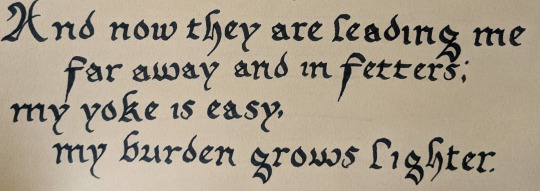
The walls of my church
are the ribs of my heart;
it seems life and I
are soon bound to part
.
My cross now rises,
traced with two fingers.
In Pustozyorsk it blazes;
its blaze will linger.
.
I’m glorified everywhere,
vilified, branded;
I have already become
the stuff of legend.
.
I was, people say,
full of anger and spite;
I suffered, I died
for the ancient rite.
.
But this popular verdict
is ugly nonsense;
I hear and reject
the implied censure.
.
The rite is nothing—
neither wrong nor right;
a rite is a trifle
in God’s sight.
.
But they attacked our faith
in the ways of the past,
in all we’d learned as children
and taken to heart.
.
In their holy garments,
in their grand hats,
with a cold crucifix
in their cold hands,
.
in thrall to a terror
clutching their souls,
they drag us to jails
and herd us to scaffolds.
.
We don’t mind about the doctrine
books and their age;
we don’t debate virtues
of fetters and chains.
.
Our dispute is of freedom,
and the right to breathe—
about the Lord’s will
to bind as he please.
.
The healers of souls
chastised our bodies;
while they schemed and plotted,
we ran to the forests.
.
Despite their decrees,
we hurled our words
out of the lion’s mouth
and into the world.
.
We called for just vengeance
against their sins;
along with the Lord,
we sang poems and hymns.
.
The words of the Lord
were claps of thunder.
The Church endures;
it will never go under.
.
And I, unyielding,
reading the Psalter,
was brought to the gates
of the Andronikov Monastery.
.
I was young;
I endured every pain:
hunger, beatings,
interrogations.
.
A winged angel
shut the eyes of the guard,
brought me cabbage soup,
and a hunk of bread.
.
I crossed the threshold—
and I walked free.
Embracing my Exile,
I walked to the east.
.
I held services
by the Amur River,
where I barely survived
the winds and blizzards.
.
They branded my cheeks
with brands of frost;
by a mountain stream
they tore out my nostrils.
.
But the path to the Lord
goes from jail to jail;
the path to the Lord
never changes.
.
And all too few,
since Jesus’s days,
have proved able to bear
God’s all-seeing gaze.
.
Nastasia, Nastasia,
do not despair;
true joy often wears
a garment of tears.
.
Whatever temptations
may beat in your heart,
whatever torments
may rip you apart,
.
walk on in peace,
through a thousand troubles
and fear not the serpent
that bites at your ankles—
.
though not from Eden
has this snake crawled;
it is an envoy of evil
from Satan’s hand.
.
Here, birdsong
is unknown;
here one learns the patience
and the wisdom of stone.
.
I have seen no color
except lingonberry
in fourteen years
spent as a prisoner.
.
But this is not madness,
nor a waking nightmare;
it is my soul’s fortress,
its will and freedom.
.
And now they are leading me
far away in fetters;
my yoke is easy
and my burden grows lighter.
.
My track is swept clean
and dusted with silver;
I’m climbing to heaven
on wings of fire.
.
Through cold and hunger,
through grief and fear
towards God, like a dove,
I will rise from the pyre.
.
O far-away Russia—
I give you my vow
to return to the sky
forgiving my foe.
.
May I be reviled,
and burned at the stake;
may my ashes be cast
on the mountain wind.
.
There is no fate sweeter,
no better end,
than to knock, as ash,
at the door of the human heart.
#this poem absolutely destroys me#there are so many threads running through it but more than anything I see such beautiful submission to God's will in it#the road to the Lord goes from jail to jail; the road to the Lord never changes#and so there's this exhortation to relish martyrdom and long for glory#like so many of the martyrs#and yet it's so uniquely personal and Soviet#that opening line: if they blow up our cathedrals and outlaw our meetings we will still carry the church in our chests#behind our ribs in our hearts#and then to say 'we don't care about the specific books or rites or liturgies we care about /freedom/#but not freedom in the way that most people in this situation would mean it in the way that he would have every right to mean it#freedom for God to bind as he please#and somehow the part that makes my heart twist most with grief is 'i have seen no color but lingonberry in fourteen years'#YET still this is not a waking nightmare; it is my soul's fortress#my soul's barren colorless fortress#but God is there#and so my yoke is easy#ughhhh this poem#and that ending#the awareness that the greatest end a person can have is to have one's death be a tertimony#if you haven't read it read Kolyma Tales#it's some of the most beautiful prose I have ever read applied to one of the most awful subjects in history#and for goodness' sake read this poem#it will do your soul good#the unquenchable fire#literature makes us more human#leah learns calligraphy#i would cut off a toe for the chance to write about this poem in a formal context#but tumblr will have to do#martyr club this is for you#russia where are you flying to?
12 notes
·
View notes
Text
*EVEN MORE YAPPING AHEAD*
Okay as of now I have finished chapter 3 of The Last Olympian and, OH MAN STUFF'S GOING DOWN.
So first off, I still find it EMBARRASSING how little Camp Halfblood does in terms of war. It's good that they started running missions but they STILL aren't a real army!
They lack a solid command structure,. They lack enough real allies (I guess the gods count as allies technically but like- it's not like they BEHAVE like allies. I mean Kronos' allies are in active communication with him to coordinate and strategize, so far it just seems tho gods are doing their own separate stuff in terms of fighting)
So far their whole strategy feels like the good old soviet approach of "throw men at the enemy and see what runs out first. Our soldiers or our enemies ammo".
EXCEPT FOR THE FACT THAT CAMP HALFBLOOD DOES NOT HAVE THE NUMBERS FOR THIS STRATEGY AND THE ENEMY WON'T EVER RUN OUT OF AMMO.
Like how have none of these people properly militarized yet!? Why are they running single man missions instead of acting as a closed force!? Why are they FIGHTING OVER LOOT INSTEAD OF PLANNING?
I will give the "why are kids planning a war" thing a pass because, well, kids book and kids wanna see themselves. BUT WHY DIDN'T CHIRON STEP IN WHEN THEY FAUGHT!?
Clarisse just dipped! And with her the entier Ares cabin! And idk if you noticed but those Ares kids LOVE fighting- so for them to just decide to sit this one out? Yeah whatever that reason is it must be GOOD. (Also very based for Clarisse. I mande it more than clear that I do not like CHB, the more people are done with it the better)
Am I the only one realizing how BAD that is!? For your main fighting force to be so divided that entier GROUPS just decide to sit it out because the rest fucked up and no one addressed the problem!?
And how come that these cabins STILL ACT MORE LOYAL INWARDS THAN TO THE ARMY!? THAT'S BAD TOO YK.
I swear if you don't wanna do the whole "united front" thing ATLEAST INTRODUCE PROPER MILITARY STRUCTURE.
You guys I am genuinly worried about CHB right now. As I see it they were already massivley underequippe to deal with Luke. Much less with KRONOS.
I mean sure they have Percy, but like- he's ONE GUY. He ain't gonna be enough to believably deal with and defeat the entier army!
Honestly at this point the only way I can see Kronos being defeated is him falling down a flight of stairs and accidentaly impaling himself on his own scythe 💀
Also on anothernote, I finally found out the entierty of that prophecy and that Percy's apperantly going to die..... and well, I feel nothing.
Like genuinly nothing.
I do not care wether he lives or dies.
I mean, I'd still PREFER it if Percy wouldn't cosplay a martyr and end up with Uncle Hades but like- even if he does it wouldn't be the worst for me.
To be quite honest I find Percy a bit boring compared to the other characters at this point. He feels to have very little to no actual conflict when next to the other characters.
Like, what sort of conflicts does Percy have?
-Shitty Dad/Parental Issues? He has a locing mom, Poseidon is one of the better Dads in terms of Gods. Gabe was a dick no doubt, but he's been taken care off for ages now and doesn't rly affect Percy much anyway. And we don#t even have the "I got no dad 😢" plotline with Percy either 'cause he as Paul now to fill that role!
-Struggling with his ADHD and dyslexia? Both had little no no impact on the story like, at all. Often times it feels like they aren't even there to beginn with.
-Luke betraying him? He immideatly switched to full on hate and enemy mentality with Luke. He doesn't struggle with the guy suddenly being evil or fighting him. Neither dies he still believe in the good in Luke like Annabeth.
-His fatal flaw? I already made a seperate post on why I don#t really like that one.
Those are the main ones comming to mind BESIDES the prophecy introduced this book. But ngl? I already lost intrest in Percy in favor of Luke. I don't REALLY care anymore.
I guess we also have the plotline with Annabeth where it's very obviously heading for a romance. But I also couldn't care less about Percabeth as a ship. At most they mildly annoy me due to the fandom shoving it down my throat whever I dabble my toes in it.
Like, yeah Percy started out cool but now? I'd rather know more about Luke, Thalia and Annabeth. I wanna know more about Clarisse. I want to know more of the innerworkings of the camp.
Percy just became a sort of, meh factor to me.
I am HOPING that it get's better though since it would be SUCH a waste if I really stayed apathetic to the main character. There are hopes with Percy in his fight with Kronos noting that it's hard for him to kill Luke/Kronos in Luke's body.
As always I ask to mark any spoilers in your rebolgs or replies should you make them, thank you very much ^^
48 notes
·
View notes
Text
Top five moments of Robert Kurvitz’s post Final Cut release statement that make Disco Elysium and its writing make all the more sense:
1. Let me tell you, to be despised in Estonia is not "cool" Estonians don't despise you in an overt and sanctifying manner. You're not a martyr, you're a joke.
2. I'm talking, of course, about the Deranged Penguin - a solitary penguin who, for no apparent reason, takes off from its flock, waddling off toward an imposing Antarctic mountain range. A solitary black spot. Receding. Thousands of miles of nothingness ahead. Herzog asks, in his guttural German accent: "But why?"
3. Soviet artists took on insane responsibilities: to fight against Heat Death, or to build a new God. The horizon was always millions of years in the future.
4. Surprise! The colossal culture monopolies of the West depend on their produce for prestige, capital gains, and planetary-scale psychological conditioning. They are quite happy without Polki Molki. Unless, it turns out, Polki Molki is a video game.
5. You have to wield yourself to an improbable degree, like a chess piece. You have to forgive and move on from things it does not feel natural to move on from. And you have to manage an immense amount of fear and paranoia.
292 notes
·
View notes
Text
In a small corner of the disintegrating Soviet Union, a young Shakespearean actor named Akhmed Zakayev stepped off the stage and took up arms.
Zakayev, like many Chechens, had been hopeful when the USSR collapsed. A new state had been declared in the capital of Grozny almost immediately, inspired by the massive and peaceful popular uprisings across the ex-Soviet satellite states: the Chechen Republic of Ichkeria.
But Moscow wasn’t keen to lose any more territory. In 1994, tanks rolled Grozny and asserted that the republic was no more: Chechnya was a member of the new Russian Federation. That’s when Zakayev joined the resistance.
Thirty years later, Zakayev is the prime minister of the Chechen Republic of Ichkeria’s government-in-exile.
“I couldn’t have imagined that my fate would become what it is today,” Zakayev told Foreign Policy during an interview in Kyiv this spring. “We’ve experienced a lot of tragedy, a lot of bloodshed, a lot of violence since 1994, when we became the victims of Russian aggression.”
For three decades, across two brutal wars waged against the Chechens, Zakayev has tried to convince the world to back his nation’s independence. He has not had much luck: Although the republic was once recognized by Georgia and Afghanistan, no nation currently explicitly recognizes its status as the government of Chechnya.
Today, many of Russia’s separatists, including Zakayev, see enormous opportunity in Ukraine’s struggle for self-defense against Moscow’s aggression. They have supported the resistance both in spirit and by joining Ukraine’s fight. This has led to an extraordinary partnership—not just with Kyiv, but also among the various dissidents hoping to be free from the Russian Federation.
Together, they believe they can bring about the end of President Vladimir Putin—and Russia itself.
The drab boardroom in which I met Zakayev, in Kyiv, is a fairly recent home for the Chechen separatists. On the table before us were the green, red, and white flag of the Republic of Ichkeria; the Ukrainian bicolor, and the European Union flag. Along the wall behind Zakayev were rows of portraits of past Chechen leaders—and the dates of their deaths, usually at Russia’s hands.
“The fact is that, for over 30 years, the world has simply been watching the Chechen tragedy,” Zakayev said. “They have simply been watching as we were being murdered, as we were being forced to leave the country, as we were being scattered across the world.”
Since the 1990s, the official U.S. position on the conflict has been simple: “We consider Chechnya a part of Russia.” That position only hardened when Washington began describing Chechnya’s paramilitary opposition to Russian rule as a movement that was affiliated with al Qaeda. Terror attacks committed against Russia in the name of the Chechen resistance have only made a change in U.S. policy more unlikely, even if serious doubts remain about the responsibility for some of those attacks.
Zakayev, who represents a more moderate wing of the Chechen resistance, has spent more than two decades since the end of the first phase of the Second Chechen War in exile, mostly in the United Kingdom. He has worked to avoid having his portrait added to the wall of martyrs.
In 2007, police at Scotland Yard warned Zakayev that he was high up on a Russian hit list. But he survived. And in 2022, as Russia launched its full-scale invasion of Ukraine, Zakayev decamped to Ukraine—“unquestionably the leader of the entire free world,” he said.
He sees plenty of parallels between their struggles. “Ukrainians have felt what it was like for us, back in 1994,” Zakayev said. “We were branded as terrorists, as Islamic extremists.”
Zakayev said that this view of the Chechens, fostered by Putin but accepted by the West, is a “great pity.” It has brought about a global view of the Chechen people as either Putin’s shock troops or as violent terrorists. These are views that Putin has relished, broadcasting images of Chechen fighters in an attempt to carry out psychological warfare in Ukraine and using Chechen contract killers to kill Russian liberals such as Boris Nemtsov. Since the start of Russia’s war in eastern Ukraine in 2014, Chechen fighters have been dispatched to fight across Ukraine.
“We are destroying this image by siding with Ukraine and by being here,” Zakayev said.
The Chechens’ support for Ukraine isn’t just symbolic. Chechen volunteers have also fought with the Ukrainians in the Donbas since 2014. Since the full-scale invasion in 2022, they have joined the Russian Legion and other militias of Russian citizens who are fighting alongside Ukraine. When he spoke to Foreign Policy in March, Zakayev’s soldiers were taking part in cross-border incursions into the Belgorod region, a precursor to Ukraine’s larger offensive in Kursk today.
“It’s a very important strategic step, of transferring the combat actions to the enemy’s territory, because it’s the first time in years that the Russians have finally felt what the war is,” Zakayev said. “Since World War II, Russia has waged a lot of wars, but they’ve never felt what a war is like on their own territory. Finally, they’re beginning to experience aid raid alarms, they’re beginning to experience explosions, and they’re starting to feel this war on their own territory.”
To that end, Zakayev no longer sees independence as a regional and isolated concern. In his eyes, independence for Chechnya—and Ukraine, Siberia, Dagestan, and other Russian subjects—can only be achieved through toppling the Russian state itself.
“Putin’s war, that he started in Ukraine, must end in Moscow,” Zakayev continued. “And the people who are going to end this war must be Russians.”
Earlier this year, a correspondent with Russian state broadcaster Channel One toured the trenches on the front lines, reviewing “trophies” taken from Ukrainian fighters killed in action. In the video, the correspondent holds up two patches removed from the fighters’ uniforms—one of which, he says, is the Canadian flag. He looks to the camera: “The presence of mercenaries in the ranks of the Ukrainian Armed Forces is no secret.”
The video prompted dozens of laughing face emojis when it was posted on Telegram by an account run by Free Ingria, a separatist movement in Russia’s Leningrad Oblast. The patch was not the Canadian red maple leaf at all, but the flag of Udmurtia, a republic in the Urals.
The Ingria separatists, who want independence for the historical Baltic region around the former imperial capital of St. Petersburg, and the Udmurtia separatists, who want an independent state in their region west of the Ural mountains, may be more than 800 miles apart, but they have recently made common cause.
It’s all thanks to Oleg Magaletsky.
Shortly after the full-scale invasion of Ukraine began, Magaletsky founded the Free Nations of Post-Russia Forum. Composed of two dozen regionalist movements from across the Russian Federation, including the Chechen Republic of Ichkeria, it has become the coordinating body for those hoping to dismantle Russia itself.
It is not the only game in town: The Lithuania-based Free Russia Forum, founded by Russian chess grandmaster and dissident Garry Kasparov, has aimed to become a think tank and philosophical hub for this post-imperial Russia.
Magaletsky’s group is much more hands-on.
“We need to be prepared for big changes—for the collapse,” Magaletsky told me, sitting in a pie shop in Kyiv.
Magaletsky is an unlikely champion for the cause of Russian secession—he’s a soft-spoken and personable Ukrainian restaurateur who was turned on to politics by the Euromaidan protests. Yet he has thrown himself into the work, and he’s moved quickly.
His forum has served as a hub to coordinate the exiled leaders of these independence movements, who, in turn, coordinate with their compatriots who are still in Russia. They’ve also held a series of summits to connect some of the leaders of Russia’s “captive nations” with academics, strategists, and government officials around the world.
When the Free Russia Forum brought some of its members to Washington for a series of talks at the Jamestown Foundation in March, they stressed just how much of Russia’s might comes from its imperial conquests: its access to the Black Sea, its natural resources, and even the fighters who feed its army.
“[There] has been a litany of trials and losses of lives, lands, resources, culture, and language, taken away by the empire,” Radjana Dugar-DePonte, the co-chair of the Buryad-Mongol Erkheten Democratic Movement, told the attendees. The Buryat people are wildly overrepresented in the death toll from the Russia-Ukraine war, as are other ethnic minorities.
When he had the opportunity, Pavel Mezerin enlisted to fight alongside the Ukrainian Armed Forces.
While Zakayev’s forces joined the fight early, more and more Russian dissidents in exile were signing up to fight with Ukraine. Magaletsky rattles off the component members of his forum and which unit they fight under. He said that some are with the Siberian Battalion, others serve with the Free Russia Legion, and others are fighting directly under the Ukrainian Armed Forces.
Mezerin, who hails from Ingria, joined the Siberian Battalion but soon grew disenchanted with the mission.
The Ukrainian leadership, he told Foreign Policy, “was not interested in forming full-fledged combat units from Russian citizens who would fight for the freedom of Russia.” They were more “political projects than actual military units,” he added. It was “a very sad experience” for Mezerin—he quit the battalion and channeled his energy through Free Ingria, of which he is a coordinator.
Mezerin told me that he perfectly understands that Ukraine’s priority is in recapturing its own territory. He has been watching afar as Ukraine has pulled off its extraordinary invasion of the Kursk region and is cheering on his former comrades. This time, however, the Ukrainians used their regular soldiers instead of Russian militias. “I sincerely envy the people of Kursk,” Mezerin said.
If it was his territory that had been “liberated” by Ukraine, he said, “of course, we would return there immediately. We would be busy organizing armed militias, armed detachments. Ingria would be free.” He dreams of Ukrainian forces continuing their march north to St. Petersburg.
But he knows that this is a fantasy. “Ukraine is not interested in these regions,” he said, recognizing that they would almost certainly be traded for Ukrainian territory in any peace talks. “Ukraine is interested in its own freedom.”
The quest for independence falls on the shoulders of activists such as Mezerin and Zakayev. And independence, Magaletsky said, cannot come from a think tank. That’s why the Free Nations of Post-Russia Forum is actively involved in helping dissidents inside Russia prepare for what comes next.
“We have public activities,” Magaletsky said cryptically. “And, of course, we have unpublic activities.”
While he was careful not to put too much stock in a single operation, Magaletsky said that anything that could dismantle the idea of a “single and indivisible” Russian state would ultimately help their cause. “It is not so much the actual operation of the Ukrainian army in the Kursk region, as the reaction of both the Kremlin and the ‘Russian people’ to it in general.”
To that end, his operation requires a diversity of tactics. “Not all movements have people who are fighting now on the front line,” Magaletsky added, before offering me some of his pie. Others, he said, have members who are still inside Russia, making plans and preparations for when things change.
“They’re preparing, not for a big war on the front line—they’re preparing for their cities fighting.”
Everyone involved said that the work is hard—and dangerous. The Free Nations of Post-Russia Forum was declared an “undesirable organization” by Moscow in 2023 and attacked as an alleged CIA front group by news outlets loyal to the Kremlin. Many of the forum’s members have faced FSB crackdowns for years, and their projects have been declared extremist organizations.
However, Magaletsky said that their work is critical. Although the West has long supported the idea of a democratic Russia, its leaders seem sure that a change at the top is all that is needed. Magaletsky disagrees: “Putin is the result,” he said. “The problem is the imperial, colonial, system of Russia.”
Kyiv is certainly sympathetic to that view. The Ukrainian Rada has recognized Chechnya as “temporarily occupied” by Russia, and it is contemplating full recognition for the independence movements for Tatarstan, Chechnya, and Bashkortostan.
The West, however, is far from any such recognition.
“We, here in Ukraine, remember, of course, the speech of [then-U.S. President] George [H.W.] Bush, the so-called ‘Chicken Kiev’ speech,” he said, referring to the president’s 1991 address to the legislature of the Ukrainian Soviet Socialist Republic, in which he warned against “suicidal nationalism” and declared that “freedom is not the same as independence.”
“Now, post-Russia chicken speeches are popular,” Magaletsky wrote to me recently. “We are trying to change that.” He will keep trying to win over converts in Western capitals. The forum held its next round of meetings in Vilnius, Lithuania, in June.
As Mezerin told me, there’s no room for fatalism. “I’m an opposition politician in exile, so I’m an optimist. Otherwise, I would have no reason to go on living.”
14 notes
·
View notes
Text
Abramov's booklet on Conrad Veidt
I have already done this material in the Veidt Facebook community, and I will probably do the same here. This is a small russian-language booklet from a hundred years ago, dedicated to Conrad. Spreading the screenshots, I will supply each of them with a translation into english. I hope this is at least clear. You can notice a very funny imprint of the Soviet era in this text. The author of this critical review, as they say, praised the Conrad so that it looks like a curse.
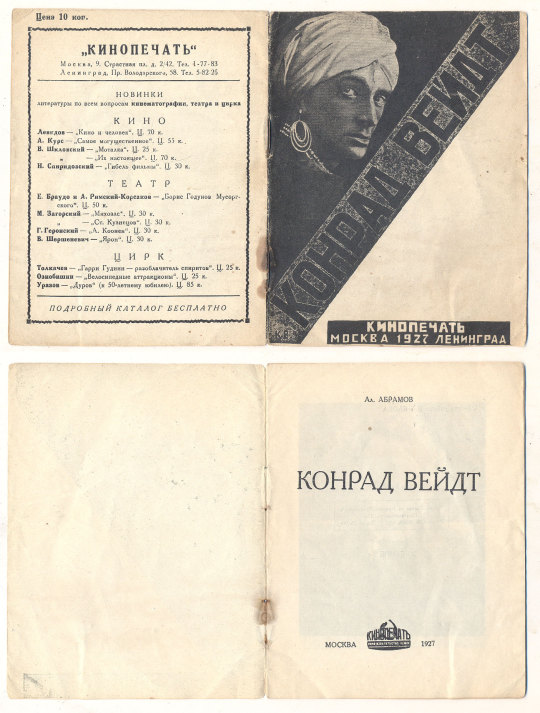
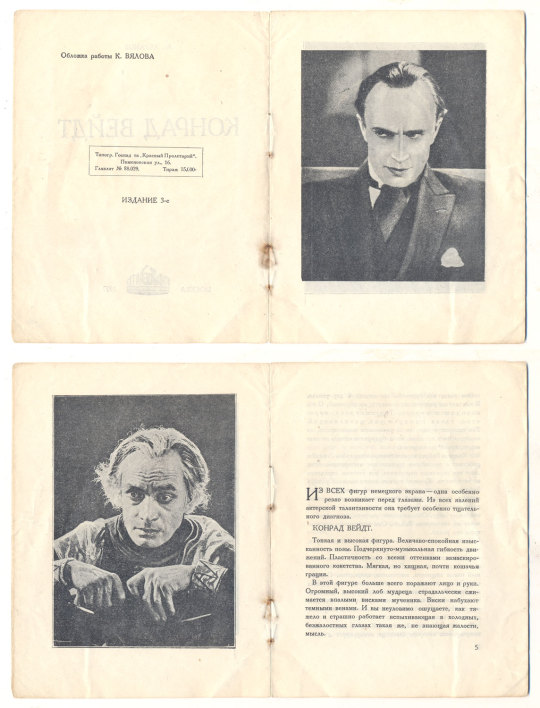
Из всех фигур немецкого экрана — одна особенно резко возникает перед глазами. Из всех явлений актерской талантливости она требует особенно тщательного диагноза.
Конрад Фейдт.
Тонкая и высокая фигура. Величаво-спокойная изысканность позы. Подчеркнуто-музыкальная гибкость движений. Пластичность со всеми оттенками замаскированного кокетства. Мягкая, но хищная, почти кошачья грация. В этой фигуре больше всего поражают лицо и руки. Огромный, высокий лоб мудреца страдальчески сжимается впалыми висками мученика. Виски набухают темными венами. И вы неуловимо ощущаете, как тяжело и страшно работает вспыхивающая в холодных, безжалостных глазах такая же, не знающая жалости, мысль.
------------------
Of all the figures on the German screen, one appears most sharply before one's eyes. Of all the manifestations of acting talent, it requires a particularly careful diagnosis.
Conrad Veidt.
Slim and tall figure. Majestically calm sophistication of the pose. Emphasized musical flexibility of movements. Plasticity with all shades of disguised coquetry. Soft, but predatory, almost feline grace.
In this figure, the face and hands are most striking. The huge, high forehead of the sage is painfully compressed by the sunken temples of the martyr. Whiskey swells with dark veins. And you imperceptibly feel how hard and terribly the same thought flashing in cold, ruthless eyes, which does not know pity, works.

Эти глаза как будто бы всё видели и всё узнали. В них нет ни радости, ни смелости, ни дерзаний. Они холодны и мертвы. Так смотрели, вероятно, глаза вымирающих цивилизаций. Так смотрят и осколки современного человечества, не верящие ни в прошлое, ни в будущее и ничего не знающие, кроме пресыщения.
У Конрада Фейдта играют больше всего губы. Эти губы работают с тончайшим техническим мастерством. Они дают все переливы настроения, все оттенки страдания и жестокости. Кривая, тонкая, почти змеиная улыбка Фейдта живет на этом лице своей самостоятельной жизнью, создавая порой почти незабываемую трагическую маску. И эта улыбка дает тон, резкий, чеканный тон всему лицу. Она оживляет рисунок, кладет отпечаток на все образы Фейдта. Она окрашивает все контуры его ролей.
Улыбка и руки. В этом — весь облик Фейдта. Руки, запоминающиеся больше всего, больше сюжета, больше названия картины. Тонкие, изящные, почти изысканные руки пианиста. В этих руках какой-то неуловимый излом хищности, жестокости, злорадства. Породистые руки аристократа могут внезапно стать руками душителя. В них тоже своя своеобразная и самостоятельная жизнь. И эти руки дают порой такие тончайшие оттенки переживаний, что всё остальное кажется лишней и ненужной деталью.
Кто же не знает этой фигуры? Кому не знакомо имя, популярность которого блестяще конкурирует с плеядой имен от Фербенкса до Валентино? Кому неизвестен образ раджи Эшнапура, мистически-жуткий абрис Сомнамбулы или болезненно-хищная, жестокая маска Борджиа?
От блестящих экранов на Фридрихштрассе до убогих полотнищ чухломских «иллюзионов» так часто возникало лицо, в котором, казалось, застыли все черты декаданса, в котором скрестились все пути человеческой дегенерации.
Фейдт пришел в кино из театра. Он из той плеяды театральных актеров, которые почувствовали кино не параллельной, а основной стихией. Театр стал параллелью.
Судя по отзывам немецкой прессы, Фейдт в кино во много раз сильнее, ярче, убедительнее Фейдта в театре.
Но и в театре Фейдт оказался в рядах пожинателей успеха и славы. Он еще у Рейнгарта был сразу замечен, когда выступал на вторых, почти случайных, эпизодических ролях. О нем часто говорили больше, чем о первых актерах.
Но Фейдт в театре — это только дополнение к Фейдту в кино. В кино он вырастает в проблему. В проблему искусства декаданса, искусства умирающей цивилизации. Он — самое острое ее проявление. Ее наиболее могучая и яркая манифестация.
Мы знаем Фейдта довольно хорошо. Мы просмотрели уже значительное количество его картин. Среди них много сравнительно слабых, но ряд и поистине блестящих, чеканно и талантливо сделанных ролей. Таковы: Сомнамбула («Кабинет доктора Калигари»), раджа Эшнапура («Индийская гробница»), Лорд Нельсон («Леди Гамильтон»), Чезаре Борджиа («Лукреция Борджиа»), О’Коннор («Ужас»), и более слабые, менее удачные роли: Христиан фон Шафф («Жемчуг, кровь и слезы»), Паганини, в картине под тем же названием, Арпадо Чарлзло («Любовь художника»), поэт («Ню»). Из других его картин довольно популярны на Западе «Граф Калиостро», «Елизавета и Дон Карлос», «Руки Орлака» и «Кабинет восковых фигур».
--------------------
Those eyes seemed to see everything and know everything. They have no joy, no courage, no daring. They are cold and dead. So looked, probably, the eyes of dying civilizations. This is how the fragments of modern humanity look, who do not believe in either the past or the future and know nothing but surfeit.
Conrad Veidt's lips play the most. These lips work with the finest technical skill. They give all modulations of mood, all shades of suffering and cruelty. Veidt's wry, thin, almost serpentine smile lives its own independent life on this face, sometimes creating an almost unforgettable tragic mask. And this smile gives a tone, a sharp, chased tone to the whole face. She revives the drawing, leaves an imprint on all the images of Veidt. She paints all the contours of his roles.
Smile and hands. This is the whole existence of Veidt. Hands that are remembered the most, more than the plot, more than the title of the picture. Thin, graceful, almost refined pianist's hands. In these hands there is some elusive kink of rapacity, cruelty, gloating. The thoroughbred hands of an aristocrat can suddenly become the hands of a strangler. They also have their own unique and independent life. And these hands sometimes give such subtle shades of experience that everything else seems like an unnecessary and excess detail.
Who doesn't know this shape? Who doesn't know a name whose popularity rivals a plethora of names from Fairbanks to Valentino? Who does not know the image of the Raja of Eshnapur, the mystical and terrible outline of Somnambula, or the painfully predatory, cruel mask of Borgia?
From the brilliant screens on Friedrichstrasse to the wretched panels of Chukhloma "illusions", so often a face appeared in which, it seemed, all the features of decadence were frozen, in which all the paths of human degeneration crossed.
Veidt came to cinema from the theatre. He is from that galaxy of theatrical actors who felt the cinema not as a parallel, but as the main element. The theater has become a parallel.
Judging by the reviews of the German press, Veidt in the cinema is many times stronger, brighter, more convincing than Veidt in the theater.
But even in the theater, Veidt found himself among the reapers of success and fame. He was immediately noticed by Reingart when he acted in second, almost random, episodic roles. He was often talked about more than the first actors.
But Veidt in the theater is only a supplement to Veidt in the cinema. In the movies, he grows into a problem. Into the problem of the art of decadence, the art of a dying civilization. It is its most acute manifestation. Its most powerful and brightest manifestation.
We know Veidt quite well. We have already seen a significant number of his paintings. Among them are many relatively weak, but a number of truly brilliant, minted and talented roles. These are: Somnambula ("The Cabinet of Dr. Caligari"), the Raja of Eshnapur ("The Indian Tomb"), Lord Nelson ("Lady Hamilton"), Cesare Borgia ("Lucretia Borgia"), O'Connor ("Horror"), and weaker, less successful roles: Christian von Schaff ("Pearls, Blood and Tears"), Paganini, in the film of the same name, Arpado Charleslo ("The Artist's Love"), poet ("Nu"). Of his other paintings, “Count Cagliostro”, “Elizabeth and Don Carlos”, “Hands of Orlak” and “Cabinet of Wax Figures” are quite popular in the West.
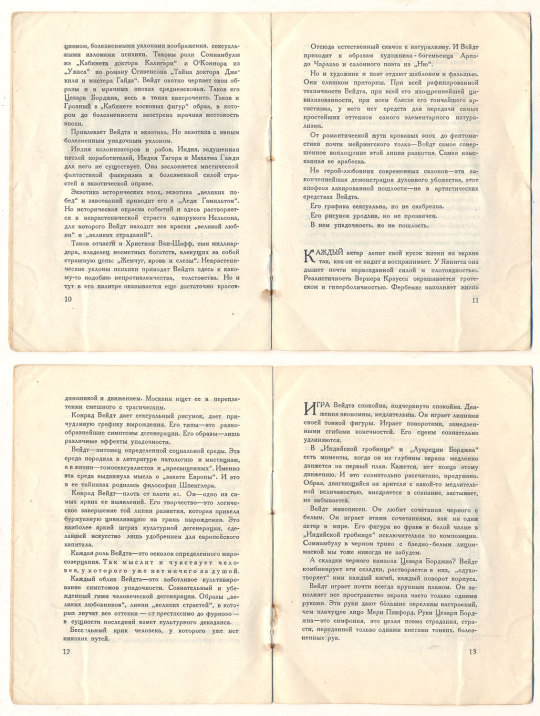
Лучшие роли Фейдта — это образы, навеянные мистицизмом, болезненными кулонами воображения, сексуальными изломами психики. Таковы роли Сомнамбулы из «Кабинета доктора Калигари» и О’Коннора из «Ужаса» по роману Стивенсона «Тайна доктора Джекилла и мистера Хайда». Фейдт охотно черпает свои образы и в мрачных эпохах Средневековья. Таков его Чезаре Борджиа, весь в тонах кватроченто. Таков и Иван Грозный в «Кабинете восковых фигур» — образ, в котором до болезненности заострена мрачная жестокость эпохи.
Привлекает Фейдта и экзотика. Но экзотика с явным болезненным упадочным уклоном.
Индия колонизаторов и рабов, Индия, задушенная петлей поработителей, Индия Тагора и Махатмы Ганди для него не существует. Она заслоняется мистической фантастикой факиризма и болезненной силой страстей в экзотической оправе.
Экзотика исторических эпох, экзотика «великих побед» и завоеваний приводит его к «Леди Гамильтон». Но историческая окраска событий и здесь растворяется в неврастенической страсти однорукого Нельсона, для которого Фейдт находит все краски «великой любви» и «великих страданий».
Таков отчасти и Христиан фон Шафф, сын миллиардера, владелец несметных богатств, влекущий за собой страшную цепь: «Жемчуг, кровь и слезы». Неврастенические уклоны психики приводят Фейдта здесь к какому-то подобию непротивленчества, толстовства. Но и тут в его палитре оказывается еще достаточно красок.
Отсюда естественный скачок к натурализму. И Фейдт приходит к образам богемного художника Арпадо Чарлзло и салонного поэта из «Ню».
Но и художник, и поэт отдают шаблоном и фальшью. Они слишком приторны. При всей рафинированной техничности Фейдта, при его изощреннейшей цивилизованности, при всем блеске его тончайшего артистизма, у него нет средств для передачи самых простейших оттенков самого элементарного натурализма.
От романтической жути кровавых эпох до фантомистики почти мейрингского толка Фейдт самое совершенное воплощение этой линии развития. Самая изысканная ее арабеска.
Но герой-любовник современных салонов — эта законченная демонстрация духовного убожества, этот апофеоз лакированной пошлости — не в артистических средствах Фейдта.
Его графика сексуальна, но не скабрезна.
Его рисунок уродлив, но не прозаичен.
В нем упадочность, но не пошлость.
Каждый актер лепит свой кусок жизни на экране так, как он ее видит и воспринимает. У Янингса она дышит почти первозданной силой и плотоядностью. Реалистичность Вернера Краусса окрашивается гротеском и гиперболичностью. Фербенкс наполняет жизнь динамикой и движением. Москвин ищет ее в переплетении смешного с трагическим.
Конрад Фейдт дает сексуальный рисунок, дает причудливую графику вырождения. Его типы — это разнообразнейшие симптомы дегенерации. Его образы — лишь различные эффекты упадочности.
Фейдт — питомец определенной социальной среды. Эта среда породила в литературе патологию и мистицизм, а в жизни — гомосексуалистов и «пресыщенных». Именно эта среда выдвинула мысль о «закате Европы». И это в ее тайниках родилась философия Шпенглера.
Конрад Фейдт — плоть от плоти ее. Он одно из самых ярких ее проявлений. Его творчество — это логическое завершение той линии развития, которая привела буржуазную цивилизацию на грань вырождения. Это наиболее яркий штрих культурной дегенерации, сделавшей искусство лишь удобрением для европейского капитала.
Каждая роль Фейдта — это осколок определенного миросозерцания. Так мыслит и чувствует человек, у которого уже нет ничего за душой.
Каждый облик Фейдта — это заботливое культивирование симптомов упадочности. Сознательный и убежденный гимн человеческой дегенерации. Образы «великих любовников», линии «великих страстей», в которых звучат все оттенки — от престиссимо до фуриозо — в сущности последний взмет культурного декаданса.
Бессильный крик человека, у которого уже нет никаких путей.
Игра Фейдта спокойна, подчеркнуто спокойна. Движения экономны, медлительны. Он играет линиями своей тонкой фигуры. Играет поворотами, замедленными сгибами конечностей. Его сцены сознательно удлиняются.
В «Индийской гробнице» и «Лукреции Борджиа» есть моменты, когда он из глубины экрана медленно движется на первый план. Кажется, нет конца этому движению. И это сознательно рассчитано, продумано. Образ, двигающийся на зрителя с какой-то медлительной величавостью, внедряется в сознание, застывает, не забывается.
Фейдт живописен. Он любит сочетания черного с белым. Он играет этими сочетаниями как ни один актер в мире. Его фигура во фраке и белой чалме в «Индийской гробнице» исключительна по композиции. Сомнамбулу в черном трико с бледно-белым лицом-маской мы тоже никогда не забудем.
А складки черного камзола Чезаре Борджиа? Фейдт комбинирует эти складки, растворяется в них, «одухотворяет» ими каждый изгиб, каждый поворот корпуса. Фейдт почти всегда играет крупным планом. Он заполняет всё пространство экрана часто только одними руками. Эти руки дают куда большие переливы настроений, чем плачущее лицо Мери Пикфорд. Руки Чезаре Борджиа — это симфония, это целая поэма страдания, страсти, переданной только одними кистями тонких болезненных рук.
-------------------------
Veidt's best roles are images inspired by mysticism, painful pendants of the imagination, sexual fractures of the psyche. Such are the roles of Sleepwalker from The Cabinet of Dr. Caligari and O'Connor from Horror, based on Stevenson's novel The Secret of Dr. Jekyll and Mr. Hyde. Veidt willingly draws his images from the dark epochs of the Middle Ages. Such is his Cesare Borgia, all in the tones of the Quattrocento. Such is Ivan the Terrible in The Cabinet of Wax Figures, an image in which the gloomy cruelty of the era is painfully pointed.
Veidt is also attracted by the exotic. But exotic with a clear morbid decadent bias.
The India of colonizers and slaves, India strangled by the noose of enslavers, the India of Tagore and Mahatma Gandhi does not exist for him. It is obscured by the mystical fantasy of fakirism and the painful power of passions in an exotic setting.
The exoticism of historical epochs, the exoticism of "great victories" and conquests leads him to "Lady Hamilton". But the historical coloring of events here, too, dissolves into the neurasthenic passion of the one-armed Nelson, for whom Veidt finds all the colors of "great love" and "great suffering."
This is partly Christian von Schaff, the son of a billionaire, the owner of untold wealth, entailing a terrible chain: "Pearls, blood and tears." Neurasthenic inclinations of the psyche lead Veidt here to some semblance of non-resistance, Tolstoyism. But even here there are still enough colors in his palette.
Hence the natural leap towards naturalism. And Veidt comes to the images of the bohemian artist Arpado Charleslo and the salon poet from "Nu".
But both the artist and the poet give off a template and falseness. They are too cloying. With all the refined technicality of Veidt, with all his most sophisticated civility, with all the brilliance of his most subtle artistry, he does not have the means to convey the simplest shades of the most elementary naturalism.
From the romantic horror of the bloody eras to the almost Meiringian phantomism, Veidt is the most perfect embodiment of this line of development. Her most exquisite arabesque.
But the hero-lover of modern salons — this complete demonstration of spiritual squalor, this apotheosis of lacquered vulgarity — is not in Veidt's artistic means.
Its graphics are sexy but not smutty.
His drawing is ugly, but not prosaic.
It is decadent, but not vulgar.
Each actor sculpts his piece of life on the screen the way he sees and perceives it. In Janings (Emil Jannings), she breathes an almost primordial strength and carnivorousness. The realism of Werner Krauss is colored with grotesque and hyperbolicity. Fairbanks fills life with dynamics and movement. Moskvin is looking for it in the interweaving of the funny with the tragic.
Conrad Veidt gives a sexy drawing, gives a bizarre degeneration graphics. Its types are the most diverse symptoms of degeneration. His images are only various effects of decadence.
Veidt is a pet of a certain social environment. This milieu gave rise to pathology and mysticism in literature, and in life to homosexuals and the “blasé”. It was this environment that put forward the idea of the “decline of Europe”. And it was in her recesses that Spengler's philosophy was born.
Conrad Veidt is flesh of her flesh. He is one of the brightest manifestations of it. His work is the logical conclusion of the line of development that brought bourgeois civilization to the brink of degeneration. This is the most striking stroke of the cultural degeneration that has made art a mere fertilizer for European capital.
Each role of Veidt is a fragment of a certain worldview. This is how a person thinks and feels, who no longer has anything in his soul.
Each character of Veidt is a careful cultivation of the symptoms of decadence. A conscious and convinced hymn to human degeneration. Images of "great lovers", lines of "great passions", in which all shades sound - from prestisimo to furioso - in essence, the last wave of cultural decadence.
The powerless cry of a man who no longer has any way.
Veidt's acting is calm, emphatically calm. Movements are economical, slow. He plays with the lines of his thin figure. Plays with turns, slow bends of the limbs. His scenes are deliberately lengthened.
There are moments in The Indian Tomb and Lucrezia Borgia when he slowly moves from the depths of the screen to the fore. There seems to be no end to this movement. And this is deliberately calculated, thought out. The image, moving towards the viewer with some kind of slow majesty, takes root in the consciousness, freezes, is not forgotten.
Veidt is picturesque. He loves black and white combinations. He plays these combinations like no other actor in the world. His figure in a tailcoat and white turban in the "Indian Tomb" is exceptional in composition. A somnambulist in a black tights with a pale white face-mask, we will never forget either.
And the folds of Cesare Borgia's black camisole? Veidt combines these folds, dissolves in them, “spiritualizes” with them every bend, every turn of the body. Veidt almost always plays in close-up. He fills the entire screen space often with only one hand. These hands give much more play of mood than the weeping face of Mary Pickford. The hands of Cesare Borgia are a symphony, a whole poem of suffering, passion, conveyed only by thin, painful hands.

В фильме «Руки Орлака» он передает тончайшие оттенки душевных переживаний только скрюченными пальцами или пассивно опущенной кистью руки.
У него играет даже ладонь, даже локти, даже предплечья. В «Леди Гамильтон» он играет Нельсона даже отсутствием руки. Целой серией тончайших приемов он подчеркивает это отсутствие, заостряет его, растворяет весь образ именно в этой однорукости.
Его средства воздействия на зрителя необычайно просты, но в то же время тонки. И именно этой простотой и тонкостью ему удается добиваться порой колоссальных эффектов. Он умеет передать всю силу страсти только одной страдальчески поникшей фигурой. Кто не помнит этой фигуры, бессильно распростершейся на ступеньках мавзолея в «Индийской гробнице»?
Несомненно, Фейдт талантлив, исключительно талантлив. Но эта талантливость еще более заостряет проблему его творчества. Даже манера игры его, даже самый стиль его артистических созданий носит характер всё той же упадочности.
Он сексуален. И эта сексуальность органически в его манере. Она сквозит в каждом жесте Чезаре Борджиа, в каждой улыбке раджи Эшнапура, в каждом движении О’Коннора. И разве не чувствуется она даже в одном только сгибе наклоненной (над постелью девушки) фигуры Сомнамбулы?
Фейдт — крупный, исключительно крупный, исключительно талантливый актер. Но этот талант не дар, а проклятие. Это ярчайшая символика распада буржуазной культуры. «Закат Европы». Талант, который мчит вперед лишь сила инерции. И мчит по путям, которые уже никуда не ведут.
--------------------------
In the film "Hands of Orlak" he conveys the subtlest shades of emotional experiences only with twisted fingers or a passively lowered hand.
He plays even the palm, even the elbows, even the forearms. In "Lady Hamilton" he plays Nelson even without his arm. With a whole series of the most subtle techniques, he emphasizes this absence, sharpens it, dissolves the whole image precisely in this one-handedness.
His means of influencing the viewer are unusually simple, but at the same time subtle. And it is precisely this simplicity and subtlety that he manages to sometimes achieve colossal effects. He knows how to convey the full power of passion with only one sufferingly drooping figure. Who does not remember this figure, prostrated helplessly on the steps of the mausoleum in the "Indian Tomb"?
Undoubtedly, Veidt is talented, exceptionally talented. But this talent sharpens the problem of his creativity even more. Even his manner of playing, even the very style of his artistic creations, bears the character of the same decadence.
He is sexy. And this sexuality is organic in his manner. It shines through in every gesture of Cesare Borgia, in every smile of the Raja of Eshnapur, in every movement of O'Connor. And isn’t it felt even in the curve of the figure of the Somnambula tilted (above the girl’s bed)?
Veidt is a large, exceptionally large, exceptionally talented actor. But this talent is not a gift, but a curse. This is the brightest symbolism of the collapse of bourgeois culture. "The Decline of Europe". Talent that rushes forward only the force of inertia. And rushes along paths that no longer lead anywhere.
67 notes
·
View notes
Text

The Martyrs of Nowogródek, also known as the Blessed Martyrs of Nowogródek, the Eleven Nuns of Nowogródek or Blessed Mary Stella and her Ten Companions, were a group of members of the Sisters of the Holy Family of Nazareth, a Polish Roman Catholic religious congregation, executed by the Gestapo in August 1943 in (by national-socialist Germany) occupied Poland.
The national-socialist German terror in Nowogródek began in 1942 with the extermination of the town's Jewish population as part of Operation Reinhard. Of the town's pre-war population of 20,000, approximately half were Jews. The Germans murdered about 9,500 of the Jews in a series of "actions" and sent the remaining 550 Jews to slave labor camps. This was followed by a surge in arrests of Poles, then the slaughter of 60 people, including two Catholic priests. This situation was repeated on 18 July 1943, when more than 120 people were arrested and slated for execution.
The women of the town turned to the Sisters to pray for the prisoners' release. After discussing the matter, the Sisters unanimously expressed their desire to offer their lives in sacrifice for the prisoners. The Superior of the community, Sister Maria Stella, C.S.F.N., shared the Sisters' decision with their local pastor, Father Zienkiewicz, telling him: "My God, if sacrifice of life is needed, accept it from us and spare those who have families. We are even praying for this intention." Almost immediately, the plans for the prisoners were changed to deportation to work camps in Germany, with some of them even being released. When the life of Zienkiewicz was threatened, the Sisters renewed their offer, saying, "There is a greater need for a priest on this earth than for us. We pray that God will take us in his place, if sacrifice of life is needed."
Without warning or provocation, on 31 July 1943, the community was summoned by the local Gestapo commander to report to the local police station, where they were held overnight. The next morning, 1 August 1943, they were loaded into a van and driven beyond the town limits. At a secluded spot in the woods about 3 miles from the town, the eleven women were machine gunned to death and buried in a common grave. Before reporting to the police station, Sister Stella had asked one member of the community, Sister M. Małgorzata Banaś, C.S.F.N., who worked as a nurse in the local public hospital, to stay behind at the convent, whatever happened, to take care of the church and their pastor. She was the best candidate for that among the community as she wore civilian clothing due to her job. It was days before she and the townspeople knew that the Sisters had been killed. Eventually, Sister Banaś located their grave, quietly tending to it and the parish church during the war years and during the post-war Soviet occupation, until her death in 1966. The Church of the Transfiguration, known as Biała Fara (or White Church), now contains the remains of the eleven Sisters.
7 notes
·
View notes
Text
Midway through Jamil Jan Kochai’s collection The Haunting of Hajji Hotak and Other Stories, which maps generations of Afghan and Afghan American lives against over a century of entwined wars, sits what appears to be a résumé. Entitled “Occupational Hazards,” it meticulously records the everyday labors of an Afghan man: [...] his “[d]uties included: leading sheep to the pastures”; from 1977–79, “gathering old English rifles” left over from the last war while being recruited into a new war; in 1980–81, “burying the tattered remnants of neighbors and friends and women and children and babies and cousins and nieces and nephews and a beloved half-sister”; [...] becoming a refugee day-laborer in Peshawar, Pakistan; in 1984, becoming a refugee in Alabama, where he worked on an assembly line with other Asian migrants whom the white factory owner used to push out the local Black workforce; and so on. Dozens of events, from the traumatic to the mundane, are cataloged one by one in prose that is at once emotionless and overwhelming. [...] Kochai interviewed his father for the résumé’s occupational trajectory [...]. An Afghan shepherd [...] is displaced by imperial wars and then, in the heart of empire, is conscripted into racialized domestic economies [...]. [M]ethodically translating lived violence via a résumé, a bureaucratic form that quantifies labor in its most banal functionality, paradoxically realizes the spectacular breadth of war and how it organizes life’s possibilities. [...]
---
In this collection, war is past, present, and plural. In Afghanistan, Kochai recounts the lives of Logaris and Kabulis, against the backdrop of the US occupation, still dealing with the detritus of previous wars - British, Soviet, and civil - including their shrines, mines, and memories. In the United States, Afghan Californians experience the diasporic conditions of war -- state neglect of refugees combined with targeted surveillance -- amid the coming-of-age of a second generation that must confront inherited traumas while struggling to build political solidarities with other displaced youth.
These 12 stories explore the reverberations between historical and psychic realities, invoking a ghostly practice of reading. Characters, living and dead, recur across the stories [...]. Wars echo one another [...]. Scenes and states mirror each other, with one story depicting Afghan bureaucracies that disavow military and police violence while another depicts US bureaucracies that deny social services to unemployed refugees. History itself is layered and unresolved [...]. Kochai, who was born in a refugee camp in Peshawar, writes from the position of the Afghan diaspora [...]. In August 2021, the US relegated Afghanistan to the past, declaring the “longest American war” over. Over for whom? one should ask. [...] War, in other words, is not an event but a structure. [...]
---
In Kochai’s collection, war is not the story; rather, war arranges the scenes and life possibilities [...]. Kochai carefully puts war itself, and the warmakers, in the narrative background [...].
This is a historically incisive narrative design for representing Afghanistan. Kochai challenges centuries of Western colonial discourses, from Rudyard Kipling to Rambo, that conflate Afghanistan with violence while erasing the international production of that violence as well as the social and conceptual worlds of Afghans themselves. Instead, this collection moves the reader across Afghans’ transcontinental, intergenerational, and multispirited social worlds -- including through stories of migrations and returns, homes populated by the living and the martyred, language that enmeshes Dari, Pashto, and Northern California slang, as well as the occasional fantastical creature [...].
---
Like Kochai’s debut novel 99 Nights in Logar (2019), this collection merges realism and the fantastic, oral and academic histories, Afghan folklore and Islamic texts, giving his fiction a dynamic relation to history. Each story is an experiment, and many of them are replete with surreal or magical elements [...].
As in Ahmed Saadawi’s 2013 novel Frankenstein in Baghdad, a nightmarish sensorium collides with a postcolonial body politics [...].
In a recent interview, Kochai said that writing about his family’s experiences of war has compelled him to explore “realms of the surreal or magical realism […] because the incidents themselves seem so unreal […]. [I]t takes years and decades to even come to terms with what had actually happened to them before their eyes.” He points not to a documentary dilemma but to an epistemological one. While some scholars have argued that fantastic genres like magical realism are often conflated with exoticized imaginaries of the Global South, others have defended the form’s critical possibilities for rendering complex realities and multiple modes of interpretation. Literary metaphors, whether magical or otherwise, are always imprecise; as Afghan poet Aria Aber puts it, “you flee into metaphor but you return / with another moth / flapping inside your throat.” [...]
Kochai does not “escape” into the surreal or magical as fictions but as other ways of reckoning with war’s pasts ongoing in the present.
---
All text above by: Najwa Mayer. “War Is a Structure: On Jamil Jan Kochai’s “The Haunting of Hajji Hotak and Other Stories.”“ LA Review of Books (Online). 20 December 2022. [Bold emphasis and some paragraph breaks/contractions added by me. Presented here for commentary, teaching, criticism.]
#haunting#tidalectics#carceral geography#intimacies of four continents#multispecies#gothic#geographic imaginaries#frankenstein in baghdad#afghan#carceral archipelago
95 notes
·
View notes
Text
If you don't know the whole truth, here's a simple historical summary to clarify things for you:
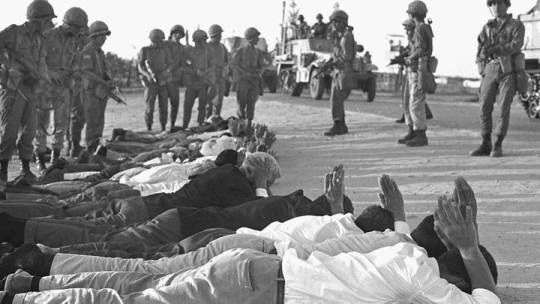
The ongoing war between Israel and Palestine is not a war between two states, so the attack of the Palestinian resistance is not a declaration of war, but only a reaction to ...
violations that have been taking place for more than 70 years .
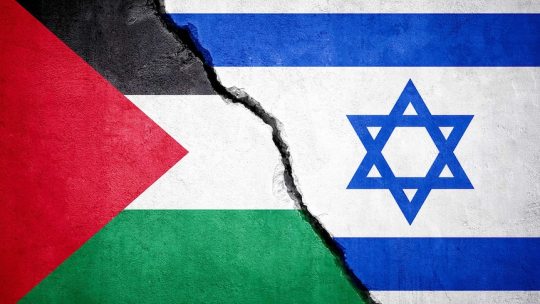
For more than a century, the Palestinian Territories belonged to the Ottoman Empire
During World War I, as the empire faltered , eventually giving way to the Republic of Türkiye –– Britain seized it.

In 1917, the British Foreign Secretary, in a letter to Lionel Rothschild, declared his full support for the establishment of a Jewish state on the Palestinian Territories
We call this promise “A promise from someone who does not possess to someone who does not deserve”

At the beginning of the implementation of this fateful promise, the number of Jews in Palestine was 7%, this percentage increased to 28% of the total population after the immigration of European Jews to Palestine under the British protectorate
After the end of World War II, the United Nations issued a resolution on the partition of Palestine between Arabs and Jews in 1947
On May 14, 1948, the leaders of Israel met at the Tel Aviv Museum and announced the end of the British Mandate and the establishment of the state of Israel was recognized by the United States of America and the Soviet Union

The 1948 War
Many Arab countries rejected the occupation of Palestine and its partition by the United States unjustly, and many wars were won in which Israel won with the support of America and took areas of land larger than the one declared by the United States
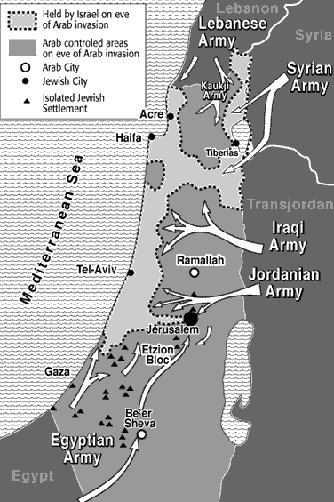
Many armed and unarmed Palestinian organizations were formed and had one demand, which was the liberation of their state, which was divided and occupied unjustly
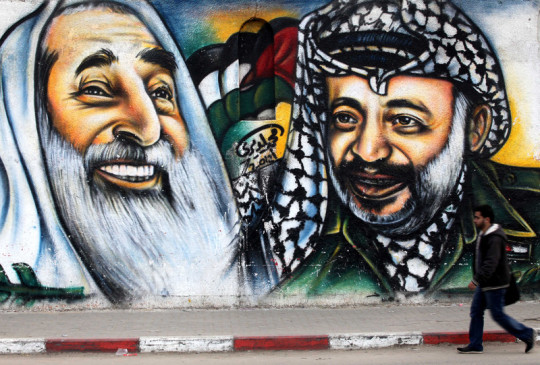
Violations against the Palestinian people are carried out on a daily and systematic basis there are more than 100 thousand registered martyrs / twice this number has not been counted and there are more than a million killed
The attacks are carried out in various aspects of life, including education, health, supplies that are constantly being cut off, violations of religious sanctities and provocation on all occasions and holidays
Israel does'nt want to give the Palestinians peace, as it claims, and does'nt want establish a state for Palestinians next to their so-called state, as the UN claims, the Palestinian map is shrinking dayily while the territories controlled by the Israeli occupation are expanding

Google for Sheikh Jarrah neighborhood , and you will see violations and settlement
The Palestinian resistance is only a reaction to daily violations that occur and no one talks about them

if you are a free person, you certainly will not accept all this hypocrisy and Distortion of facts from the international community
Pray for Palestine and support Palestine

#palestine#israel#arab#gaza#jerusalem#islam#free palestine#i stand with palestine#فلسطين#pray for palestine#I support Palestine
29 notes
·
View notes
Text
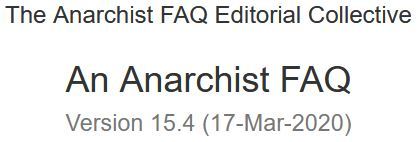
A.5 What are some examples of “Anarchy in Action”?
A.5.2 The Haymarket Martyrs
May 1st is a day of special significance for the labour movement. While it has been hijacked in the past by the Stalinist bureaucracy in the Soviet Union and elsewhere, the labour movement festival of May Day is a day of world-wide solidarity. A time to remember past struggles and demonstrate our hope for a better future. A day to remember that an injury to one is an injury to all.
The history of Mayday is closely linked with the anarchist movement and the struggles of working people for a better world. Indeed, it originated with the execution of four anarchists in Chicago in 1886 for organising workers in the fight for the eight-hour day. Thus May Day is a product of “anarchy in action” — of the struggle of working people using direct action in labour unions to change the world.
It began in the 1880s in the USA. In 1884, the Federation of Organised Trades and Labor Unions of the United States and Canada (created in 1881, it changed its name in 1886 to the American Federation of Labor) passed a resolution which asserted that “eight hours shall constitute a legal day’s work from and after May 1, 1886, and that we recommend to labour organisations throughout this district that they so direct their laws as to conform to this resolution.” A call for strikes on May 1st, 1886 was made in support of this demand.
In Chicago the anarchists were the main force in the union movement, and partially as a result of their presence, the unions translated this call into strikes on May 1st. The anarchists thought that the eight hour day could only be won through direct action and solidarity. They considered that struggles for reforms, like the eight hour day, were not enough in themselves. They viewed them as only one battle in an ongoing class war that would only end by social revolution and the creation of a free society. It was with these ideas that they organised and fought.
In Chicago alone, 400 000 workers went out and the threat of strike action ensured that more than 45 000 were granted a shorter working day without striking. On May 3, 1886, police fired into a crowd of pickets at the McCormick Harvester Machine Company, killing at least one striker, seriously wounding five or six others, and injuring an undetermined number. Anarchists called for a mass meeting the next day in Haymarket Square to protest the brutality. According to the Mayor, “nothing had occurred yet, or looked likely to occur to require interference.” However, as the meeting was breaking up a column of 180 police arrived and ordered the meeting to end. At this moment a bomb was thrown into the police ranks, who opened fire on the crowd. How many civilians were wounded or killed by the police was never exactly ascertained, but 7 policemen eventually died (ironically, only one was the victim of the bomb, the rest were a result of the bullets fired by the police [Paul Avrich, The Haymarket Tragedy, p. 208]).
A “reign of terror” swept over Chicago, and the “organised banditti and conscienceless brigands of capital suspended the only papers which would give the side of those whom they crammed into prison cells. They have invaded the homes of everyone who has ever known to have raised a voice or sympathised with those who have aught to say against the present system of robbery and oppression … they have invaded their homes and subjected them and their families to indignities that must be seen to be believed.” [Lucy Parsons, Liberty, Equality & Solidarity, p. 53] Meeting halls, union offices, printing shops and private homes were raided (usually without warrants). Such raids into working-class areas allowed the police to round up all known anarchists and other socialists. Many suspects were beaten up and some bribed. “Make the raids first and look up the law afterwards” was the public statement of J. Grinnell, the States Attorney, when a question was raised about search warrants. [“Editor’s Introduction”, The Autobiographies of the Haymarket Martyrs, p. 7]
Eight anarchists were put on trial for accessory to murder. No pretence was made that any of the accused had carried out or even planned the bomb. The judge ruled that it was not necessary for the state to identify the actual perpetrator or prove that he had acted under the influence of the accused. The state did not try to establish that the defendants had in any way approved or abetted the act. In fact, only three were present at the meeting when the bomb exploded and one of those, Albert Parsons, was accompanied by his wife and fellow anarchist Lucy and their two small children to the event.
The reason why these eight were picked was because of their anarchism and union organising, as made clear by that State’s Attorney when he told the jury that “Law is on trial. Anarchy is on trial. These men have been selected, picked out by the Grand Jury, and indicted because they were leaders. They are no more guilty than the thousands who follow them. Gentlemen of the jury; convict these men, make examples of them, hang them and you save our institutions, our society.” The jury was selected by a special bailiff, nominated by the State’s Attorney and was explicitly chosen to compose of businessmen and a relative of one of the cops killed. The defence was not allowed to present evidence that the special bailiff had publicly claimed “I am managing this case and I know what I am about. These fellows are going to be hanged as certain as death.” [Op. Cit., p. 8] Not surprisingly, the accused were convicted. Seven were sentenced to death, one to 15 years’ imprisonment.
An international campaign resulted in two of the death sentences being commuted to life, but the world wide protest did not stop the US state. Of the remaining five, one (Louis Lingg) cheated the executioner and killed himself on the eve of the execution. The remaining four (Albert Parsons, August Spies, George Engel and Adolph Fischer) were hanged on November 11th 1887. They are known in Labour history as the Haymarket Martyrs. Between 150,000 and 500,000 lined the route taken by the funeral cortege and between 10,000 to 25,000 were estimated to have watched the burial.
In 1889, the American delegation attending the International Socialist congress in Paris proposed that May 1st be adopted as a workers’ holiday. This was to commemorate working class struggle and the “Martyrdom of the Chicago Eight”. Since then Mayday has became a day for international solidarity. In 1893, the new Governor of Illinois made official what the working class in Chicago and across the world knew all along and pardoned the Martyrs because of their obvious innocence and because “the trial was not fair.” To this day, no one knows who threw the bomb — the only definite fact is that it was not any of those who were tried for the act: “Our comrades were not murdered by the state because they had any connection with the bomb-throwing, but because they had been active in organising the wage-slaves of America.” [Lucy Parsons, Op. Cit., p. 142]
The authorities had believed at the time of the trial that such persecution would break the back of the labour movement. As Lucy Parsons, a participant of the events, noted 20 years later, the Haymarket trial “was a class trial — relentless, vindictive, savage and bloody. By that prosecution the capitalists sought to break the great strike for the eight-hour day which as being successfully inaugurated in Chicago, this city being the stormcentre of that great movement; and they also intended, by the savage manner in which they conducted the trial of these men, to frighten the working class back to their long hours of toil and low wages from which they were attempting to emerge. The capitalistic class imagined they could carry out their hellish plot by putting to an ignominious death the most progressive leaders among the working class of that day. In executing their bloody deed of judicial murder they succeeded, but in arresting the mighty onward movement of the class struggle they utterly failed.” [Lucy Parsons, Op. Cit., p. 128] In the words of August Spies when he addressed the court after he had been sentenced to die:
“If you think that by hanging us you can stamp out the labour movement … the movement from which the downtrodden millions, the millions who toil in misery and want, expect salvation — if this is your opinion, then hang us! Here you will tread on a spark, but there and there, behind you — and in front of you, and everywhere, flames blaze up. It is a subterranean fire. You cannot put it out.” [quoted by Paul Avrich, Op. Cit., p. 287]
At the time and in the years to come, this defiance of the state and capitalism was to win thousands to anarchism, particularly in the US itself. Since the Haymarket event, anarchists have celebrated May Day (on the 1st of May — the reformist unions and labour parties moved its marches to the first Sunday of the month). We do so to show our solidarity with other working class people across the world, to celebrate past and present struggles, to show our power and remind the ruling class of their vulnerability. As Nestor Makhno put it:
“That day those American workers attempted, by organising themselves, to give expression to their protest against the iniquitous order of the State and Capital of the propertied …
“The workers of Chicago … had gathered to resolve, in common, the problems of their lives and their struggles…
“Today too … the toilers … regard the first of May as the occasion of a get-together when they will concern themselves with their own affairs and consider the matter of their emancipation.” [The Struggle Against the State and Other Essays, pp. 59–60]
Anarchists stay true to the origins of May Day and celebrate its birth in the direct action of the oppressed. It is a classic example of anarchist principles of direct action and solidarity, “an historic event of great importance, inasmuch as it was, in the first place, the first time that workers themselves had attempted to get a shorter work day by united, simultaneous action … this strike was the first in the nature of Direct Action on a large scale, the first in America.” [Lucy Parsons, Op. Cit., pp. 139–40] Oppression and exploitation breed resistance and, for anarchists, May Day is an international symbol of that resistance and power — a power expressed in the last words of August Spies, chiselled in stone on the monument to the Haymarket martyrs in Waldheim Cemetery in Chicago:
“The day will come when our silence will be more powerful than the voices you are throttling today.”
To understand why the state and business class were so determined to hang the Chicago Anarchists, it is necessary to realise they were considered the leaders of a massive radical union movement. In 1884, the Chicago Anarchists produced the world’s first daily anarchist newspaper, the Chicagoer Arbeiter-Zeiting. This was written, read, owned and published by the German immigrant working class movement. The combined circulation of this daily plus a weekly (Vorbote) and a Sunday edition (Fackel) more than doubled, from 13,000 per issues in 1880 to 26,980 in 1886. Anarchist weekly papers existed for other ethnic groups as well (one English, one Bohemian and one Scandinavian).
Anarchists were very active in the Central Labour Union (which included the eleven largest unions in the city) and aimed to make it, in the words of Albert Parsons (one of the Martyrs), “the embryonic group of the future ‘free society.’” The anarchists were also part of the International Working People’s Association (also called the “Black International”) which had representatives from 26 cities at its founding convention. The I.W.P.A. soon “made headway among trade unions, especially in the mid-west” and its ideas of “direct action of the rank and file” and of trade unions “serv[ing] as the instrument of the working class for the complete destruction of capitalism and the nucleus for the formation of a new society” became known as the “Chicago Idea” (an idea which later inspired the Industrial Workers of the World which was founded in Chicago in 1905). [“Editor’s Introduction,” The Autobiographies of the Haymarket Martyrs, p. 4]
This idea was expressed in the manifesto issued at the I.W.P.A.‘s Pittsburgh Congress of 1883:
“First — Destruction of the existing class rule, by all means, i.e. by energetic, relentless, revolutionary and international action.
“Second — Establishment of a free society based upon co-operative organisation of production.
“Third — Free exchange of equivalent products by and between the productive organisations without commerce and profit-mongery.
“Fourth — Organisation of education on a secular, scientific and equal basis for both sexes.
“Fifth — Equal rights for all without distinction to sex or race.
“Sixth — Regulation of all public affairs by free contracts between autonomous (independent) communes and associations, resting on a federalistic basis.” [Op. Cit., p. 42]
In addition to their union organising, the Chicago anarchist movement also organised social societies, picnics, lectures, dances, libraries and a host of other activities. These all helped to forge a distinctly working-class revolutionary culture in the heart of the “American Dream.” The threat to the ruling class and their system was too great to allow it to continue (particularly with memories of the vast uprising of labour in 1877 still fresh. As in 1886, that revolt was also meet by state violence — see Strike! by J. Brecher for details of this strike movement as well as the Haymarket events). Hence the repression, kangaroo court, and the state murder of those the state and capitalist class considered “leaders” of the movement.
For more on the Haymarket Martyrs, their lives and their ideas, The Autobiographies of the Haymarket Martyrs is essential reading. Albert Parsons, the only American born Martyr, produced a book which explained what they stood for called Anarchism: Its Philosophy and Scientific Basis. Historian Paul Avrich’s The Haymarket Tragedy is a useful in depth account of the events.
#community building#practical anarchy#practical anarchism#anarchist society#practical#faq#anarchy faq#revolution#anarchism#daily posts#communism#anti capitalist#anti capitalism#late stage capitalism#organization#grassroots#grass roots#anarchists#libraries#leftism#social issues#economy#economics#climate change#climate crisis#climate#ecology#anarchy works#environmentalism#environment
8 notes
·
View notes
Text

Blessed Eugene Bossilkov C.P.
Bishop, Martyr
Born November 16, 1900
Died November 11, 1952 (aged 51)
Venerated in Roman Catholic Church
Beatified1998, Rome, Italy by Pope John Paul II
Feast November 13
More Saints of the Day Novembre 13
St. Frances Xavier Cabrini
St. Abbo
St. Arcadius and Companions
Bl. Vincent Bossilkov
St. Brice
St. Caillin
St. Chillien
St. Dalmatius of Rodez
St. Devinicus
St. Didacus
St. Gredifael
St. Homobonus
St. Maxellendis
St. Mitrius
St. Quintian
#catholic#saint#saints#blessed martyr#martyrs#pray for us#bl vincent bossilkov#bulgaria#soviet#stalin
2 notes
·
View notes
Text

It is only by being a prisoner for religious convictions in a Soviet camp that one can really understand the mystery of the fall of the first man, the mystical meaning of the redemption of all creation, and the great victory of Christ over the forces of evil. It is only when we suffer for the ideals of the Holy Gospel that we can realize our sinful infirmity and our unworthiness in comparison with the great martyrs of the first Christian Church. Only then can we grasp the absolute necessity for profound meekness and humility, without which we cannot be saved; only then can we begin to discern the passing image of the seen, and the eternal life of the Unseen.
On Easter Day all of us who were imprisoned for religious convictions were united in the one joy of Christ. We were all taken into one feeling, into one spiritual triumph, glorifying the one eternal God. There was no solemn Paschal service with the ringing of church bells, no possibility in our camp to gather for worship, to dress up for the festival, to prepare Easter dishes. On the contrary, there was even more work and more interference than usual. All the prisoners here for religious convictions, whatever their denomination, were surrounded by more spying, by more threats from the secret police.
Yet Easter was there: great, holy, spiritual, unforgettable. It was blessed by the presence of our risen God among us -- blessed by the silent Siberian stars and by our sorrows. How our hearts beat joyfully in communion with the great Resurrection! Death is conquered, fear no more, an eternal Easter is given to us! Full of this marvellous Easter, we send you form our prison camp the victorious and joyful tidings: Christ is risen!
-- Letter from a Soviet concentration camp
22 notes
·
View notes
Text
If you don't know the whole truth, here's a simple historical summary to clarify things for you:
The ongoing war between Israel and Palestine is not a war between two states, so the attack of the Palestinian resistance is not a declaration of war, but only a reaction to
...violations that have been taking place for more than 70 years .
For more than a century, the Palestinian Territories belonged to the Ottoman Empire
During World War I, as the empire faltered , eventually giving way to the Republic of Türkiye –– Britain seized it.
In 1917, the British Foreign Secretary, in a letter to Lionel Rothschild, declared his full support for the establishment of a Jewish state on the Palestinian Territories
We call this promise “A promise from someone who does not possess to someone who does not deserve”
At the beginning of the implementation of this fateful promise, the number of Jews in Palestine was 7%, this percentage increased to 28% of the total population after the immigration of European Jews to Palestine under the British protectorate
After the end of World War II, the United Nations issued a resolution on the partition of Palestine between Arabs and Jews in 1947
On May 14, 1948, the leaders of Israel met at the Tel Aviv Museum and announced the end of the British Mandate and the establishment of the state of Israel was recognized by the United States of America and the Soviet Union
The 1948 War
Many Arab countries rejected the occupation of Palestine and its partition by the United States unjustly, and many wars were won in which Israel won with the support of America and took areas of land larger than the one declared by the United States
Many armed and unarmed Palestinian organizations were formed and had one demand, which was the liberation of their state, which was divided and occupied unjustly
Violations against the Palestinian people are carried out on a daily and systematic basis there are more than 100 thousand registered martyrs / twice this number has not been counted and there are more than a million killed
The attacks are carried out in various aspects of life, including education, health, supplies that are constantly being cut off, violations of religious sanctities and provocation on all occasions and holidays
Israel does’nt want to give the Palestinians peace, as it claims, and does’nt want establish a state for Palestinians next to their so-called state, as the UN claims, the Palestinian map is shrinking dayily while the territories controlled by the Israeli occupation are expanding
Google for Sheikh Jarrah neighborhood , and you will see violations and settlement
The Palestinian resistance is only a reaction to daily violations that occur and no one talks about them
If you are a free person, you certainly will not accept all this hypocrisy and Distortion of facts from the international community
Pray for Palestine and support Palestine 🇵🇸
24 notes
·
View notes
Text
This post is addressed to non-Arab users
Check the french version here
If you don't know the whole truth, here's a simple historical summary to clarify things for you:
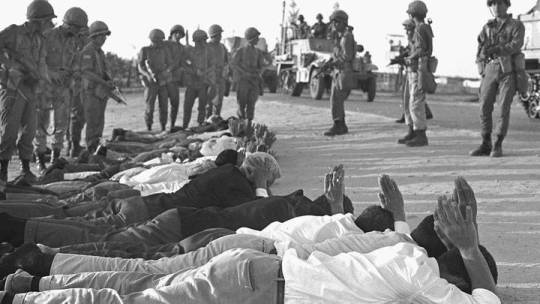
The ongoing war between Israel and Palestine is not a war between two states, so the attack of the Palestinian resistance is not a declaration of war, but only a reaction to ...
violations that have been taking place for more than 70 years .
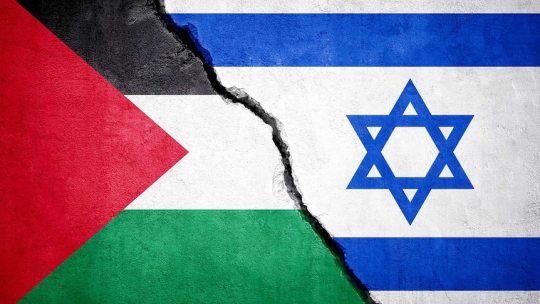
For more than a century, the Palestinian Territories belonged to the Ottoman Empire
During World War I, as the empire faltered , eventually giving way to the Republic of Türkiye –– Britain seized it.

In 1917, the British Foreign Secretary, in a letter to Lionel Rothschild, declared his full support for the establishment of a Jewish state on the Palestinian Territories
We call this promise “A promise from someone who does not possess to someone who does not deserve”
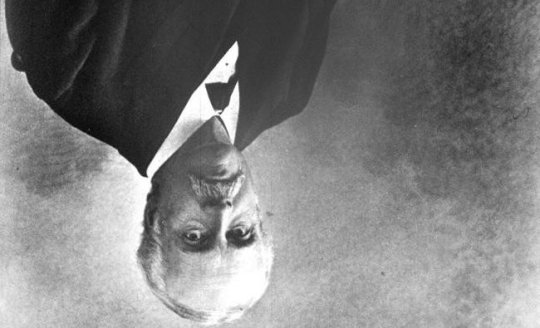
At the beginning of the implementation of this fateful promise, the number of Jews in Palestine was 7%, this percentage increased to 28% of the total population after the immigration of European Jews to Palestine under the British protectorate
After the end of World War II, the United Nations issued a resolution on the partition of Palestine between Arabs and Jews in 1947
On May 14, 1948, the leaders of Israel met at the Tel Aviv Museum and announced the end of the British Mandate and the establishment of the state of Israel was recognized by the United States of America and the Soviet Union
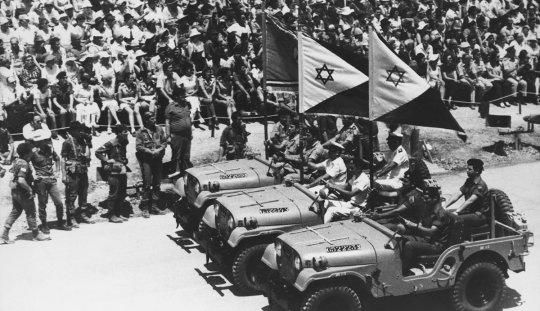
The 1948 War
Many Arab countries rejected the occupation of Palestine and its partition by the United States unjustly, and many wars were won in which Israel won with the support of America and took areas of land larger than the one declared by the United States

Many armed and unarmed Palestinian organizations were formed and had one demand, which was the liberation of their state, which was divided and occupied unjustly

Violations against the Palestinian people are carried out on a daily and systematic basis there are more than 100 thousand registered martyrs / twice this number has not been counted and there are more than a million killed
The attacks are carried out in various aspects of life, including education, health, supplies that are constantly being cut off, violations of religious sanctities and provocation on all occasions and holidays
Israel does'nt want to give the Palestinians peace, as it claims, and does'nt want establish a state for Palestinians next to their so-called state, as the UN claims, the Palestinian map is shrinking dayily while the territories controlled by the Israeli occupation are expanding

Google for Sheikh Jarrah neighborhood , and you will see violations and settlement
The Palestinian resistance is only a reaction to daily violations that occur and no one talks about them

if you are a free person, you certainly will not accept all this hypocrisy and Distortion of facts from the international community
Pray for Palestine and support Palestine
French version
Sourse
34 notes
·
View notes
Text
If you don't know the whole truth, here's a simple historical summary to clarify things for you:
The ongoing war between Israel and Palestine is not a war between two states, so the attack of the Palestinian resistance is not a declaration of war, but only a reaction to violations that have been taking place for more than 70 years .
For more than a century, the Palestinian Territories belonged to the Ottoman Empire
During World War I, as the empire faltered , eventually giving way to the Republic of Türkiye –– Britain seized it.
In 1917, the British Foreign Secretary, in a letter to Lionel Rothschild, declared his full support for the establishment of a Jewish state on the Palestinian Territories
We call this promise “A promise from someone who does not possess to someone who does not deserve”
At the beginning of the implementation of this fateful promise, the number of Jews in Palestine was 7%, this percentage increased to 28% of the total population after the immigration of European Jews to Palestine under the British protectorate
After the end of World War II, the United Nations issued a resolution on the partition of Palestine between Arabs and Jews in 1947
On May 14, 1948, the leaders of Israel met at the Tel Aviv Museum and announced the end of the British Mandate and the establishment of the state of Israel was recognized by the United States of America and the Soviet Union.
The 1948 War
Many Arab countries rejected the occupation of
Palestine and its partition by the United States
unjustly, and many wars were won in which Israel won with the support of America and took areas of land larger than the one declared by the United States.
Many armed and unarmed Palestinian organizations were formed and had one demand, which was the liberation of their state, which was divided and occupied unjustly.
Violations against the Palestinian people are carried out on a daily and systematic basis. There are more than 100 thousand registered martyrs / twice this number has not been counted, and there are more than a million killed.
The attacks are carried out in various aspects of life, including education, health, and supplies that are
constantly being cut off, violations of religious
sanctities and provocation on all occasions and
holidays.
Israel doesn't want to give the Palestinians peace, as it claims, and doesn't want to establish a state for Palestinians next to their so-called state, as the UN claims, the Palestinian map is shrinking dayily while the territories controlled by the Israeli occupation are expanding.
Google for Sheikh Jarrah neighbourhood , and you will see violations and settlement
The Palestinian resistance is only a reaction to daily violations that occur, and no one talks about them.
if you are a free person, you certainly will not accept all this hypocrisy and distortion of facts from the international community
Pray for Palestine and support Palestine.
https://bit.ly/3M0Qomn
https://bit.ly/3trnzsR
https://bit.ly/3QeA7g9
25 notes
·
View notes